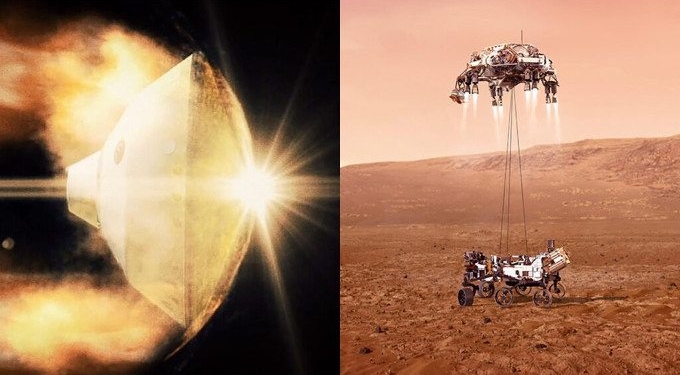
By | TheMindUnleashed.com
NASA’s Perseverance rover is en route to Mar and expected to arrive on Thursday on the surface of the Red Planet, where it will land near the dried-out lakebed Jezero Crater.
NASA is hoping to finally find solid evidence of alien life in our solar system at the ancient lakebed and will be deploying its six-wheeled Perserverence rover for this purpose. The Perseverance rover will be the first rover to land on the Martian surface since 2012 and will include two major upgrades: a microphone and its very own helicopter.
The researchers at the U.S. space agency chose the ancient Jezero Crater as a landing site due to its significance as a once-thriving home to Martian life that was swimming with microbes and potentially other forms of life.
According to the NASA science team, over 3.5 billion years ago Mars was a major water world that teemed with rivers and lakes. Among these bodies of water was the lakebed at Jezero Crater, which was filled with water and formed a deep lake roughly the same size as Lake Tahoe.
During this period, rivers fed Lake Jezero with the rich clay minerals of the region, likely also feeding microbes into the lake where they were trapped. However, as the climate of the Red Planet changed, Lake Jezero eventually dried up while surface water across Mars vanished.
However, NASA scientists believe that due to the likelihood that microbes dwelled in the ancient lakebed, there is a strong likelihood that they will find fossil rocks known as stromatolites along what was once the shoreline of the lake, as well as the dried-up river delta in the area.
Mars remains inhospitable for any form of life to exist on its planetary surface. However, the Mars 2020 mission is to learn whether life ever existed on the planet. For this purpose, the Perseverance rover will be studying rocks, taking pictures with its nearly two dozen cameras, and bring samples back to Earth.
“The science team identified Jezero Crater as basically an ancient lakebed,” said Mars 2020 flight director of cruise operations Matt Smith in a video released by NASA. “And one of the most promising places to look for evidence of ancient microbial life and to collect samples for a future return to Earth. The problem is it’s a much more hazardous place to land.”
The #CountdownToMars continues! @NASAPersevere is less than a week away from landing, and you can join in now: https://t.co/F7QsMbcHPZ
📸 Take a selfie on Mars or Mission Control
✏️ Build your own mission
📺 Watch live landing coverage! pic.twitter.com/wHp2NiYqNh— NASA JPL (@NASAJPL) February 12, 2021
One of the most challenging aspects of the mission will be the actual landing of the rover at the site, which will include an upgraded rocket pack known as the sky crane as well as advanced technologies dubbed the Range Trigger and Terrain-Relative Navigation, which will detect any potential hazards in the landing zone. Perseverance will also be equipped with a miniature helicopter drone equipped with cameras that will fly over the site later in the year.
The space agency will also be sharing the dramatic scene of the rover being lowered to the Martian surface by the sky crane before its wheels drop into place, NASA engineer David Gruel told NPR.
“And then the jet engines start to kick up dust from the surface of Mars,” Gruel said. “As the vehicle disappears into that dust and gets ready to land on Mars, it’s going to be awesome.”
















